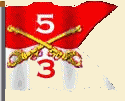


Notice: This is the official website of the All Empires History Community (Reg. 10 Feb 2002)
The Battle of Flodden Field |
Post Reply 
|
| Author | |
Chookie 
Pretorian 

Joined: 14-Apr-2008 Location: Alba Online Status: Offline Posts: 171 |
 Quote Quote  Reply Reply
 Topic: The Battle of Flodden Field Topic: The Battle of Flodden FieldPosted: 22-Aug-2011 at 17:37 |
|
The Battle of Flodden took place on 9th September 1513. On the face of it this was nothing more than yet another instance of Scots and English having a go at each other – just because they were Scots and English, but this isn't so, even though both sides were, on occasion, guilty of just that. It was, in fact, part of the War of the League of Cambrai (sometimes referred to as the War of the Holy League). This war, believe it or not, was a major conflict in the Italian Wars. The principal participants of the war, which was fought from 1508 to 1516, were France, the Papal States and the Republic of Venice; they were joined, at various times, by nearly every significant power in Western Europe, including Spain (Castile and Aragon, in actuality), the Holy Roman Empire, England, Scotland, plus the Duchies of Milan, Florence, and Ferrara. Not forgetting the army of Swiss mercenaries hired by Pope Julius II. How did Scotland get involved in this? Simply because of the Auld Alliance which was basically a mutual self-defence pact against England. How England got involved was by Henry VIII, deciding that, as the French were busy elsewhere, he could use the occasion to expand his holdings in northern France. He concluded the Treaty of Westminster—a pledge of mutual aid against the French—with Ferdinand II of Aragon in November 1511. That's a little background to the blood-letting – which, I feel is something often omitted in talking about battles(the background, that is) – so, getting back to the battle (which we haven't as this is only the lead-up). James IV of Scotland is asked by the current French king (Louis XII) do something to distract the English. James IV decided this distraction would take the form of an invasion of England. He summoned an army of around 30,000, not all of whom actually turned up, but he got support from the highlands in the shape of MacLean of MacLean, with a thousand men, and 5,000 Frenchmen. So, at the beginning of the campaign he would have had approximately 27,000. He also had the one of the best equipped artillery corps in Europe – not that you'd know this from the result... I've seen some really laughable estimations of the numbers involved, Sir Brian Tuke, Henry VIII's private secretary (who wasn't there) reckoned the Scots put 60,000 men in the field, of whom 17,000 died. Other commentators are less extravagant with numbers. The consensus seems to be an Allied force of 30,000 versus 25,000 English. For the times and equipment, that's a 50/50 chance. Believe it or not, James informed the English four weeks before the event that he would be invading. This was according to his concept of honour (but not mine), anyway this gives the English time to collect an army of their own. Now, as Bluff King Hal was away in France doing nasty things to the locals, he wasn't available to advise the northern magnates (on the other hand, they had been fighting the Scots for years so they might just have known a bit about what they were doing...). However, given this warning the English manage to scare up a good few thousand men of their own under the command of the Earl of Surrey (Thomas Howard), Baron Thomas Dacre and strangely, the Lord High Admiral of England (a different Thomas Howard). The Allies had around 27,000 to 30,000, making this the largest Scottish army ever to invade England, while the English reportedly had 25,000. The English forces are outnumbered by the Scottish/French army, but not by much. On the other hand, the Allies have more and better guns, the high ground and long pointy things known as pikes. But the pike is something the Scots knew very little about. The French contingent brought 20,000 or so of what was becoming the preferred infantry weapon in Europe but it was strange to the locals. Given the preferred heavy seven or eight foot spear a Lowland Scots schiltrom was a match for anything except an arrowstorm - the pike however was a new thing. While it had been issued and they had practised a bit with it, they knew next to nothing about it's use in battle. The English artillery, though inferior to the Allies, was better placed, being on lower ground and not having to muck about with powder charges was much more effective. The Allied artillery, being on higher ground have to experiment with their powder charges and are, therefore far less effective than the English. The Allied guns are shooting over and not doing much at all to the English, yet the English guns are having a field day as even if their shot falls short, it bounces and, in effect they are firing grazing shots every time a gun fires. Grazing shots are by far the preferred option against ranked infantry at this period in time because of the damage they do. I've mentioned that the pike was a pretty new weapon to the Scots (who preferred a shorter, heavier spear). I didn't mention the weapon of the English infantry so I will now rectify that error. The English foot were equipped with the bill. This is a weapon which is far more useful than a pike at close quarters as it's shorter, slightly heavier and far more manoeuvrable. The pike was best employed against cavalry due to the number of sharp pointy things which horses didn't like, but the bill was more versatile as it could be used against both cavalry (with difficulty) and foot – with far more effectiveness. There is a famous Scots song (written in the aftermath of the last Jacobite Rising, by Jean Elliot, a daughter of Sir Gilbert Elliot of Minto, the Lord Justice Clerk) about the battle in which the following lines appear:- “Dule and wae for the order Dule and wae (Sorrow and woe), certainly, but totally wrong. It wasn't “English guile” which won the day – it was the total and complete incompetence of the Scottish commanders, especially one named James Stewart, fourth king of that name. For some reason unknown to me, but probably his unique view of his personal honour (it has been suggested that he ordered this move because he had been outflanked), James orders his army to advance (from the high ground, where the English foot couldn't get near them). As the English couldn't get near them, why bother advancing? There is a sort of half-believed folk tale among historians on both sides that before leaving their positions the Scottish lords in James's division removed their footwear in order to gain better purchase on the ground they were advancing into. This is total bloody nonsense. A medieval battlefield was covered with sharp pointy things (arrows, swords, daggers, axes and other bits of metal which are not nice to bare feets). Plus, when it comes to hand-to-hand combat, bare feet are a disadvantage when the opposition are still shod... Anyways, the Scots are the recipients of a total ass-whuppin (see Richard S, Ah kin spoked Appalaichin). The king, assorted nobles, a bishop or two and some Highland chiefs are killed, as are approximately 5,000 others. The English lost something between 1,500 and 4,000 (most of whom were of the “common sort”). This discrepancy in the losses suffered by the nobility on both sides is due to the fact that although the Scots had adopted the fashionable European weapon, they retained their insistence on commanding from the front whereas the English, while using their more traditional billhook, were also using the new European command style where the commanders stood back and supervised the battle. This is the memorial to the battle It's inscribed “TO THE DEAD OF BOTH NATIONS”. It wasn't erected until 1910. This is a more recent commemoration:- http://news.bbc.co.uk/1/hi/scotland/south_of_scotland/5335632.stm Sources: Kightly, C., Flodden-the Anglo-Scots War of 1513, 1975. Barr, N., Flodden 1513, 2001 |
|
|
For money you did what guns could not do.........
|
|
 |
|
Nick1986 
Emperor 

Mighty Slayer of Trolls Joined: 22-Mar-2011 Location: England Online Status: Offline Posts: 7940 |
 Quote Quote  Reply Reply
 Posted: 22-Aug-2011 at 18:28 Posted: 22-Aug-2011 at 18:28 |

Great thread Chookie. In this case chivalry seems to have been James' downfall during this transitional time between medieval and early-modern warfare. I may be wrong, but didn't Catherine send Henry the bloodstained coat of James? |
|
|
Me Grimlock not nice Dino! Me bash brains!
|
|
 |
|
Nick1986 
Emperor 

Mighty Slayer of Trolls Joined: 22-Mar-2011 Location: England Online Status: Offline Posts: 7940 |
 Quote Quote  Reply Reply
 Posted: 22-Aug-2011 at 19:27 Posted: 22-Aug-2011 at 19:27 |

Here's a picture of the English billhook, originally an all-purpose farm tool similar to the machete. In wartime these would be fixed to long shafts. A spear point and extra spike would be welded to the blunt edge, transforming it into an all-purpose halberd that could be used to hack, stab and crush |
|
|
Me Grimlock not nice Dino! Me bash brains!
|
|
 |
|
Centrix Vigilis 
Emperor 

Joined: 18-Aug-2006 Location: The Llano Online Status: Offline Posts: 7392 |
 Quote Quote  Reply Reply
 Posted: 22-Aug-2011 at 20:24 Posted: 22-Aug-2011 at 20:24 |
|
I echo the praise. Well done Chookie. Definitive, accurate and enlightening analysis. I enjoy the simple style of it's presentation and can only say this is what academics, on the podium, should strive for...instead of the duller 'read the chapter and present me with a three page double spaced typed synopsis'. This is the style I used while on the aforementioned and it was always a winner in gaining and maintaining their attention. Couple this with a 'staff ride' if feasible and it's great stuff.
I also commend you, and found it particularly gratifying, for the inclusion of the following: ''It was, in fact, part of the War of the League of Cambrai (sometimes referred to as the War of the Holy League ....''
This is an excellent example of remembering the overview of historical events and interrelated cause and effect among more then the just obvious participants, especially in dealing with a noted battle. Far to often the reverse of the old adage 'can't see the trees in the forest' is found...and the forest is lost.
Well done and I encourage you to continue your reasearch, tweaking, editing and writing on this interesting period in history. This kind of work is what we need in the magazine.
CV Edited by Centrix Vigilis - 22-Aug-2011 at 20:28 |
|
|
"Absence of evidence is not evidence of absence"
S. T. Friedman Pilger's law: 'If it's been officially denied, then it's probably true' |
|
 |
|
Post Reply 
|
| Forum Jump | Forum Permissions  You cannot post new topics in this forum You cannot reply to topics in this forum You cannot delete your posts in this forum You cannot edit your posts in this forum You cannot create polls in this forum You cannot vote in polls in this forum |
Copyright ©2001-2009 Web Wiz
This page was generated in 0.082 seconds.











 Printable Version
Printable Version Google
Google Delicious
Delicious Digg
Digg StumbleUpon
StumbleUpon Windows Live
Windows Live Yahoo Bookmarks
Yahoo Bookmarks reddit
reddit Facebook
Facebook MySpace
MySpace Newsvine
Newsvine Furl
Furl Topic Options
Topic Options